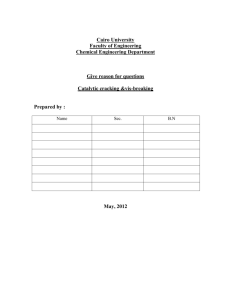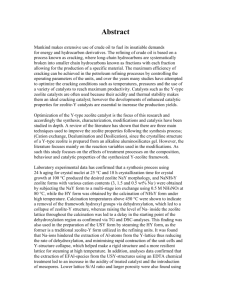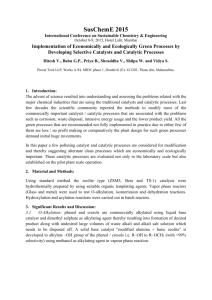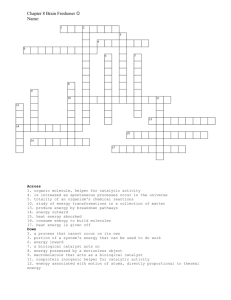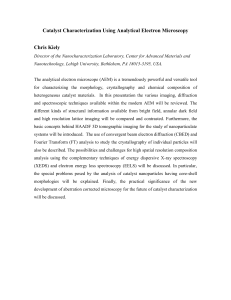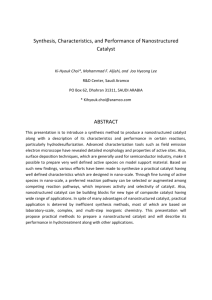Catalytic Cracking
advertisement
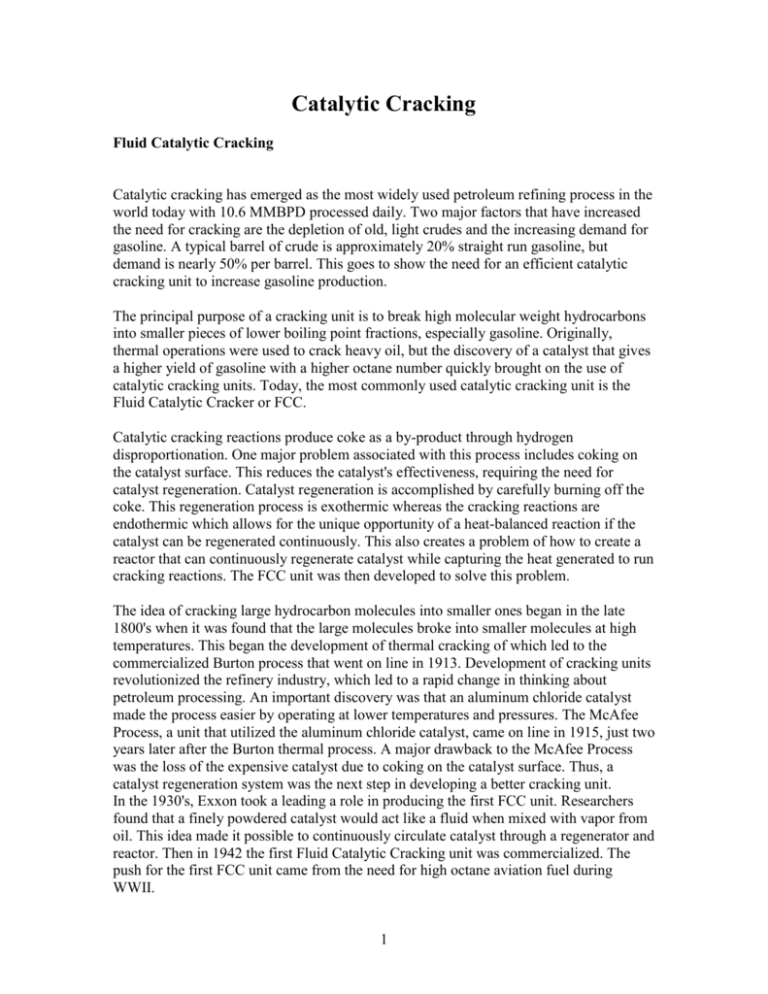
Catalytic Cracking Fluid Catalytic Cracking Catalytic cracking has emerged as the most widely used petroleum refining process in the world today with 10.6 MMBPD processed daily. Two major factors that have increased the need for cracking are the depletion of old, light crudes and the increasing demand for gasoline. A typical barrel of crude is approximately 20% straight run gasoline, but demand is nearly 50% per barrel. This goes to show the need for an efficient catalytic cracking unit to increase gasoline production. The principal purpose of a cracking unit is to break high molecular weight hydrocarbons into smaller pieces of lower boiling point fractions, especially gasoline. Originally, thermal operations were used to crack heavy oil, but the discovery of a catalyst that gives a higher yield of gasoline with a higher octane number quickly brought on the use of catalytic cracking units. Today, the most commonly used catalytic cracking unit is the Fluid Catalytic Cracker or FCC. Catalytic cracking reactions produce coke as a by-product through hydrogen disproportionation. One major problem associated with this process includes coking on the catalyst surface. This reduces the catalyst's effectiveness, requiring the need for catalyst regeneration. Catalyst regeneration is accomplished by carefully burning off the coke. This regeneration process is exothermic whereas the cracking reactions are endothermic which allows for the unique opportunity of a heat-balanced reaction if the catalyst can be regenerated continuously. This also creates a problem of how to create a reactor that can continuously regenerate catalyst while capturing the heat generated to run cracking reactions. The FCC unit was then developed to solve this problem. The idea of cracking large hydrocarbon molecules into smaller ones began in the late 1800's when it was found that the large molecules broke into smaller molecules at high temperatures. This began the development of thermal cracking of which led to the commercialized Burton process that went on line in 1913. Development of cracking units revolutionized the refinery industry, which led to a rapid change in thinking about petroleum processing. An important discovery was that an aluminum chloride catalyst made the process easier by operating at lower temperatures and pressures. The McAfee Process, a unit that utilized the aluminum chloride catalyst, came on line in 1915, just two years later after the Burton thermal process. A major drawback to the McAfee Process was the loss of the expensive catalyst due to coking on the catalyst surface. Thus, a catalyst regeneration system was the next step in developing a better cracking unit. In the 1930's, Exxon took a leading a role in producing the first FCC unit. Researchers found that a finely powdered catalyst would act like a fluid when mixed with vapor from oil. This idea made it possible to continuously circulate catalyst through a regenerator and reactor. Then in 1942 the first Fluid Catalytic Cracking unit was commercialized. The push for the first FCC unit came from the need for high octane aviation fuel during WWII. 1 Catalytic cracking was pursued as a desirable process over thermal cracking for two major reasons. The first reason being that catalytic cracking gives more control over the products by breaking large hydrocarbons more towards the middle minimizing the yield of light hydrocarbons and maximizing the yield of gasoline. Also, the gasoline produced in catalytic cracking is of much higher quality, namely a higher octane number. This is due to the skeletal isomerization, dealkylation of aromatics, and dehydrogenation reactions that take place in a reactor. Thus, the reason for the development of the catalytic cracker over thermal units is because of the higher yield and quality of gasoline. Process Parameters The FCC unit is very flexible with the ability to crack feedstocks from naphtha to pretreated residue. The process variables that enable the FCC to be so flexible are catalyst activity, temperature, catalyst/oil ratio, space velocity, and contact time. Feedstocks to the FCC unit typically include the heavy vacuum gas oil fraction though, with boiling point ranges of 640-980 F. The range of feedstocks fed to a FCC is limited by the upper boiling point because of high metal content in the heavier streams. Four major influences of feedstock that affect the FCC unit are Conradson Carbon residue, metals, sulfur, and nitrogen content. Conradson Carbon residue gives a high yield of coke, which decreases the catalyst activity. Metals and nitrogen in the feed also reduce catalyst activity. Sulfur is released as SO2, H2S, and sulfur in the distillate. Modern catalyst technology has helped make catalytic cracking the most used process in the refining industry today. High yields of high-octane gasoline are obtained in today's FCC units using a high activity zeolite-based catalyst held in a matrix of amorphous silica-alumina. The pore diameters of the zeolite catalyst prevent large hydrocarbons from passing through until cracked giving a high conversion of the feedstock. Thus, pore size governs the conversion of feedstock to specific fractions. Typical operations of the FCC unit are given on Table 1, which is adapted from Gary and Handwerk. Table 1: Parameters of FCC Parameters FCC Reactor Space Velocity (lb/hr/lb) 1.1-13.4 C/O (v/hr/lb) 5-16 Recycle/Fresh Feed 0-.5 Catalyst Requirement, lb/bbl Feed .15-.25 Cat. Crclt. Rate, ton Cat./BBl total feed .9-1.5 On-Steam Efficiency 96-98 Reactor Temp. (F) 885-950 Regenerator Temp. (F) 1200-1500 Reactor Pressure (psig) 8-30 Regenerator Pressure (psig) 15-30 RON 92-99 MON 80-85 2 Within normal operations, increasing reaction temperature, catalyst/oil ratio, catalyst activity, and contact time will yield a higher conversion of feedstock. An increase in space velocity will decrease conversion. References 1. Sadeghbeigi, Reza, Fluid Catalytic Cracking Handbook, Gulf Publishing Co., Houston, 1995. 2. Gray, Murray, Upgrading Petroleum Residues, Marcel Dekker Inc., New York. 1994. 3. Hengstebeck, R. J., Petroleum Processing Principles and Applications. McGraw-Hill, New York, 1959. 4. The North American Catalysis Society (NACS), http://WWW.nacatsoc.org/edu_fcc.asp 5. Gary, James, Glenn Handwerk, Petroleum Refining Technology and Economics fourth edition. Marcel Dekker Inc., New York. 2001. 6. Jones, D. S. , Elements of Petroleum Processing, John Wiley & Sons., New York, 1995. 7. BetzDearborn http://www.betzdearborn.com 8. OSHA http://www.osha-slc.gov/dts/osta/otm/otm_iv/otm_iv_2.html#1 9. Kvaerner E&C S. Africa http://www.mbendi.co.za/kvaerner/engineeringfocus/refinery_data/rd_04.htm 10. Petroleum Processing http://www.ems.psu.edu/~eser/CHE432/ 3 Interaction of Matrix and Zeolite in Catalytic Cracking Volume 5 Issue 1 Introduction Modern fluid catalytic cracking (FCC) catalysts are composed of crystalline zeolite Y which is surrounded and held together by an amorphous silica/alumina matrix. Matrix contributes significantly to the overall performance of FCC catalysts. Many of the functions of the catalyst matrix such as upgrading bottoms, reducing SOx emissions, and passivating catalyst poisons have been described previously (Ref. 1-4). In this paper we will illustrate how matrix can interact with the zeolite in the cracking process to affect conversion and selectivity. It will be shown that the catalyst matrix can be tailored to provide refiners with desired product quality and quantity. Therefore, in selecting FCC catalysts refiners should understand the type of matrix they need for their particular application. Synergy of Matrix and Zeolite Increases Conversion To demonstrate how matrix and zeolite interact to crack gas oil molecules, catalysts with varying matrix types were prepared and their selectivities measured using Engelhard's micro-activity test (MAT) unit. All MAT runs used Engelhard's standard mid-continent gas oil, a catalyst-to-oil ratio of 5, a weight hourly space velocity of 15 and a reactor temperature of 910°F (488°C)(Ref. 5). In this article a catalyst's activity is reported either as a MAT conversion, which is the weight percent of gas oil converted to products boiling below 421°F (216°C), or as a dimensionless activity based on second order kinetics, where Activity = Conversion /(100-Conversion). The MAT products gasoline, light cycle oil (LCO), and bottoms are defined as the fractions to 421°F (216°C),421 to 602°F (or 216 to 317°C), and >602°F (317°C), respectively. Fresh catalysts were steam deactivated at temperatures of 1350°F (732°C) or 1450°F (790°C) for periods of 4 to 8 hours prior to testing. Within each set of experiments, the same steaming severity was used for each catalyst. In the first set of experiments, the cracking activities of three catalysts were determined. Catalyst 1 was a rare earth exchanged Y (REY) zeolite catalyst with minimal matrix activity and Catalyst 2 was a moderate activity amorphous catalyst. MAT conversions of Catalysts 1 and 2 were 52 wt.% and 30 wt.%, respectively. The zeolite catalyst's activity (1.1) was nearly three times higher than that of the amorphous catalyst (0.4) . A third catalyst was prepared from a blend of the first two so that it had the same zeolite activity as the first plus the same amorphous activity as the second. If the effects of matrix and zeolite were additive, the activity of Catalyst 3 would be calculated to be 1.1+0.4 = 1.5. In fact, when the activity was measured, it was found to be 50% higher than the calculated value. 4 The experimentally determined MAT conversion of Catalyst 3 was 69 wt.%, which is equal to an activity of 2.2. These results are summarized in Figure 1. The fact that the measured activity of Catalyst 3 is substantially greater than the sum of the activities of the other two catalysts indicates that there is significant interaction between the components. This synergistic interaction can be explained by a mechanism of initial matrix cracking of large feedstock molecules to smaller ones, and subsequent zeolite cracking of the smaller molecules to converted products. The mechanism of primary matrix cracking of hydrocarbons followed by secondary zeolite cracking can be better understood when the zeolite pore size is considered. The zeolite pore size is not suitable for cracking large hydrocarbon molecules since the pores are too small (< 8 Angstroms in diameter) to allow them to diffuse to the cracking sites. The zeolite catalyst in this experiment, for example, can convert only about half of the feed to products having a boiling point below 421°F (216°C). With the addition of the amorphous catalyst which contains larger pores ( >50 Angstroms) however, many additional molecules can be cracked on the more accessible matrix cracking sites. Relatively few of the products of matrix cracking are in the gasoline boiling range or lighter, so by the above definition, the amorphous catalyst provides minimal "conversion". The amorphous catalyst does, however, produce a wide range of intermediate, partially cracked products whose boiling points exceed 421°F (216°C ). These intermediate products, when added to the lighter feed molecules that are already of a size allowing diffusion into the zeolite, significantly increase the fraction of hydrocarbon molecules which are available for zeolite cracking. The result is a synergistic interaction between matrix and zeolite in which the activity attained by their combined effects is far greater than the sum of their individual effects. Staged MAT Reactor Experiment Determines Effects of Sequential Cracking "Staged bed" MAT experiments can be used to illustrate the interaction of matrix and zeolite even more clearly. A second experiment was run using a 2 stage MAT reactor bed, where the stages were layers of different catalyst types. The same feedstock and catalysts were used in these staged-bed experiments as were used in the previous single-bed experiments. 5 In the first experimental run, the staged bed MAT reactor had a lower layer of the high zeolite, low matrix activity catalyst and an upper layer of the moderately active amorphous catalyst. With the oil vapors flowing downward through the reactor, the oil contacted the amorphous catalyst first and the zeolite catalyst second. In the second run, the catalyst layers were reversed so that the oil vapors first contacted the zeolite catalyst and then the amorphous catalyst. Both runs used the same reaction conditions and equal amounts of catalyst. The results of the staged bed MAT runs are shown in Table 1. They indicate that the "matrix-first" configuration has a large conversion advantage over the "zeolite first" run. With the "matrix-first" configuration, a conversion of 69 wt.% was achieved. With the catalyst beds reversed, the conversion dropped to 51 wt.%. Compared on an activity basis, the "matrix-first" catalyst arrangement had more than twice the activity (2.2) of the other arrangement (1.0). Other investigators have observed similar improvements in MAT conversion when an amorphous catalyst preceded a zeolite catalyst(Ref. 6). 6 The results of the staged bed MAT runs demonstrate more clearly the interaction of matrix cracking and zeolite cracking. With the matrix bed ahead of the zeolite, conversion improved by 18 wt%, with about 80% of the additional conversion occurring by the cracking of bottoms. The bottoms molecules that were unconverted in the "zeolite first" run are upgraded to valuable products (gasoline and LCO) in the "matrix first" run. The selectivities of converted products are also better when the matrix contacts the feed first and precracks it. In the "matrix first" run, dry gas selectivity declined 25%, and coke selectivity declined 36%, relative to the "zeolite first" run. Comparing the zeolite catalyst results in Figure 1 and the "zeolite first" staged bed results in Table 1 shows that the MAT conversions achieved in the two experiments are nearly equal. The matrix bed of the staged bed experiment does not enhance cracking of gas oil which has already been cracked by the zeolite. This suggests that the matrix can promote primary cracking of relatively large hydrocarbon molecules such as those found in a fresh feed, but it is inactive to smaller, less reactive hydrocarbons such as those generated from zeolite cracking. 7 Matrix Type Affects Selectivities Matrix acidity can be characterized using various techniques. The acid type, strength, and performance characteristics of two different matrix systems having comparable surface areas were distinguished by taking infrared (IR) spectra of sorbed pyridine on matrices(Ref. 7), by a n-hexadecane cracking test reaction(Ref. 8), and by MAT studies. The first method uses infrared spectroscopy to determine how much of a basic material such as pyridine remains on an acid catalyst at elevated temperature relative to the amount adsorbed at a lower temperature. This gives a measure of the strength of acid sites since a stronger acid will require a higher temperature to break the acidbase interaction, and will therefore retain more pyridine. Study results demonstrated that matrix S had much greater pyridine retention at elevated temperatures than matrix W, indicating that it contains much stronger acid sites than matrix W. As shown in Figure 2, matrix S retained approximately 70% of the adsorbed pyridine at 450°C(842°F) as compared to only 20% for matrix W. Model compound MAT test results using n-hexadecane (C16H34) as feed showed 70% higher olefins and aromatics formed for matrix S than for matrix W, indicating that a strongly acidic matrix increases gasoline octane. These results are summarized in Table 2. A MAT comparison of matrix S and matrix W using standard gas oil showed that matrix W had only half the cracking activity of matrix S but better liquid selectivities. These results are summarized in Table 3. 8 How matrix acidity and surface area can be manipulated to optimize cracking selectivity and octane is illustrated in the final set of experiments. In these studies three catalyst formulations, each with a different tape of matrix and having REY as the zeolite component, were tested in the MAT unit using the normal single stage reactor configuration. The matrix types that were used varied in composition, surface area and acidity of cracking sites. The MAT yields of the three catalysts at 70 wt.% conversion are shown in Table 4. The term "matrix activity" used in the table refers to the combined effects of matrix acidity and surface area. The test results show that significantly different selectivities result depending on the type of matrix used. Catalyst A, which has the lowest matrix activity, has the highest yields of coke and gas and the lowest yields of the most valuable liquid products (gasoline and LCO). This is because the few matrix sites in Catalyst A are strongly acidic and promote overcracking of gasoline. Catalyst B, with its moderately active matrix, has the lowest coke and gas yields. It also provides much improved yields of valuable products compared to Catalyst A. Catalyst C, which has the highest matrix activity, produces yields that generally fall between those of Catalyst A and Catalyst B. These results suggest that there is an 9 optimum level of matrix activity for each situation, below which or above which valuable products will be degraded to less valuable products. MAT paraffin-to-olefin ratios of the C4's are included in Table 4 to indicate the relative octane trend of the three catalysts. Higher gasoline octane is expected when the iC4/C4= ratio is lower. On this basis Catalyst C would have the highest gasoline octane, followed by Catalyst B, and then Catalyst A. Because Catalyst A produced higher yields of coke and gas, lower liquid products, and poorer octane, we conclude that a low activity matrix offers no performance benefits. In contrast, the catalysts with higher matrix activity, Catalysts B and C, provide varying degrees of improvement in selectivities and product quality. Conclusion FCC catalyst matrix plays a key role in determining overall activity, selectivity, and octane trends. Matrix provides primary cracking sites, generating intermediate feed molecules for further cracking to desirable products by the internal zeolite sites. The type of matrix used in the cracking catalyst alters activity and selectivities and can be controlled by the manufacturer to meet specific refining needs. References 1. Silverman, L.D.; Winkler, W.S.; Tiethof, J.A. and Witoshkin, A. Paper AM-8662, N.P.R.A. Annual Meeting, March 23-25, 1986. 2. Otterstedt, J.E.; Zhu, Y.M. and Sterte, J. Appl. Catal., 38, 143-55 (1988). 10 3. Otterstedt, J.E.; Gevert, S.B.; Jaeraas, S.G. and Menon, P.G. Appl. Catal., 22, 159-79 (1986). 4. Scherzer, J. and McArthur, D.P. Ind. Eng. Chem. Res., 27, 1571-6 (1988). 5. Speronello, B.K. and Reagan, W.R. Oil Gas J., 82, 139 (1984). 6. Ritter, R.E. and Young, G.W. Paper AM-84-57, N.P.R.A. Annual Meeting, March 25-27, 1984. 7. Parry, E.P., J. Catal., 2, (1963), 371. 8. Gladrow, G.M.; Krebs, R.W. and Kimberlin, C.N. Ind. Eng. Chem. Prod. Res. & Dev. 45 (1953) 142-147. [An abbreviated version entitled "FCC Matrix/Zeolite Interactions" was published in the February 1990 issue of HYDROCARBON PROCESSING, pp 55-56.] 11
